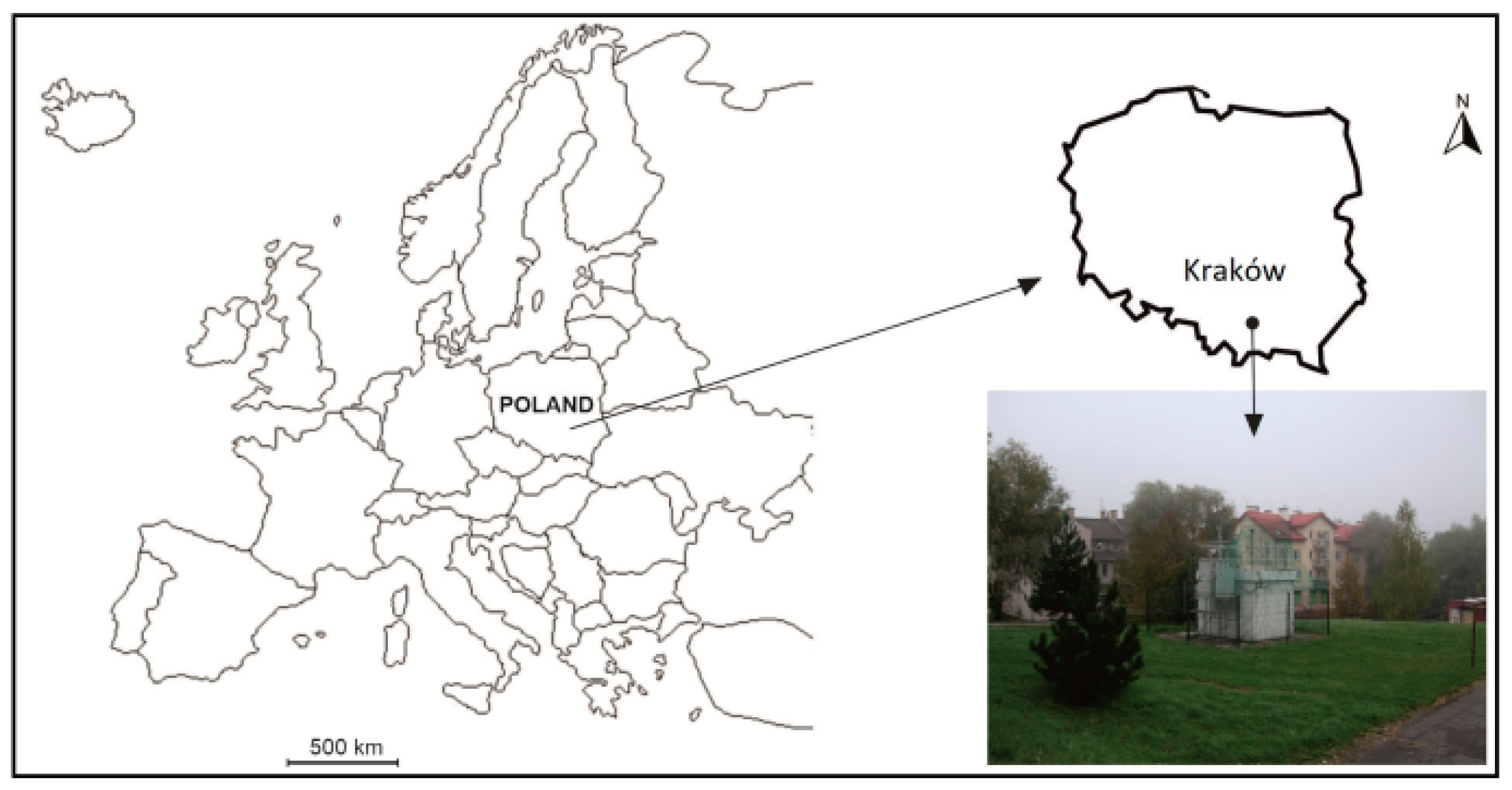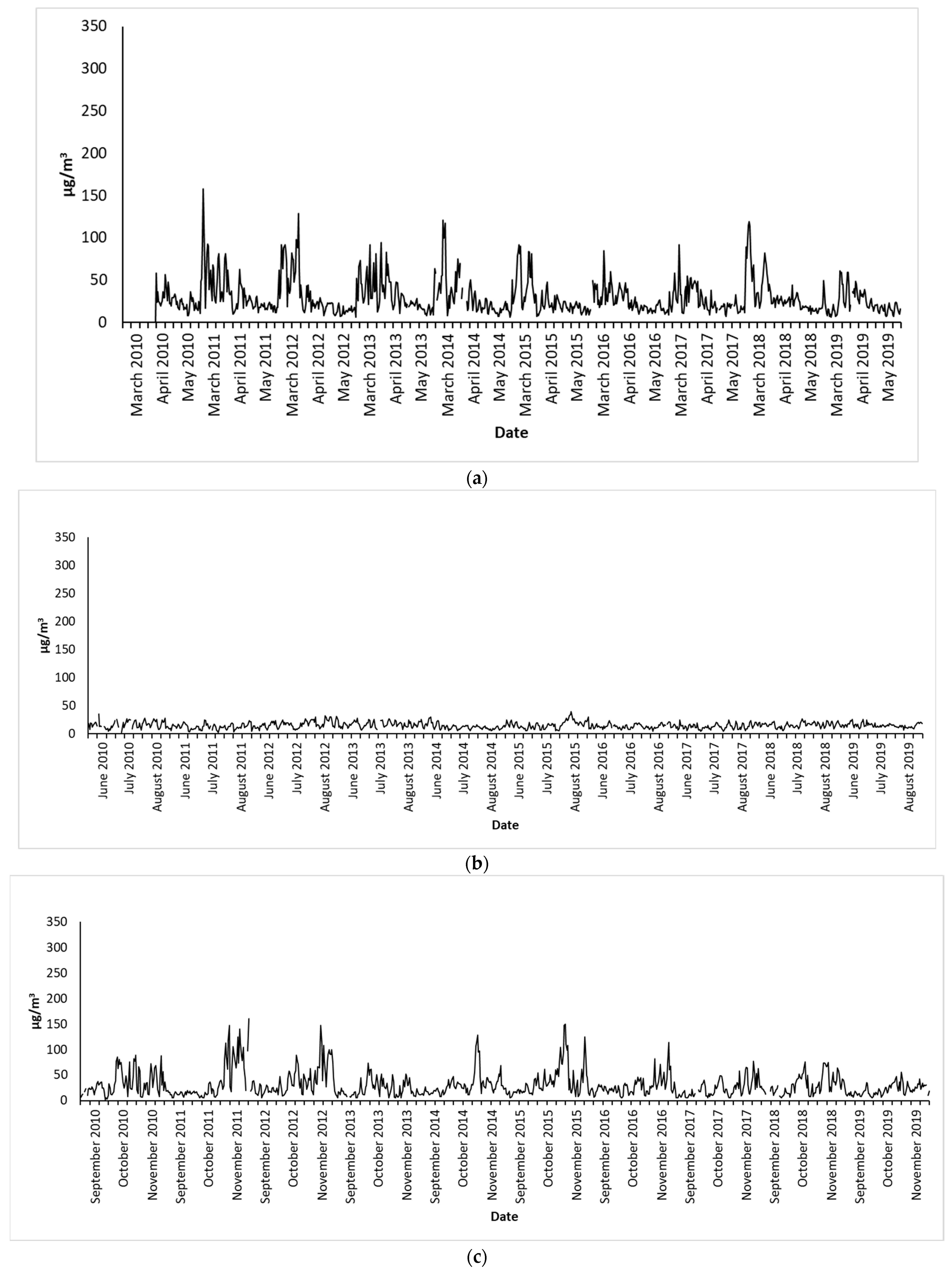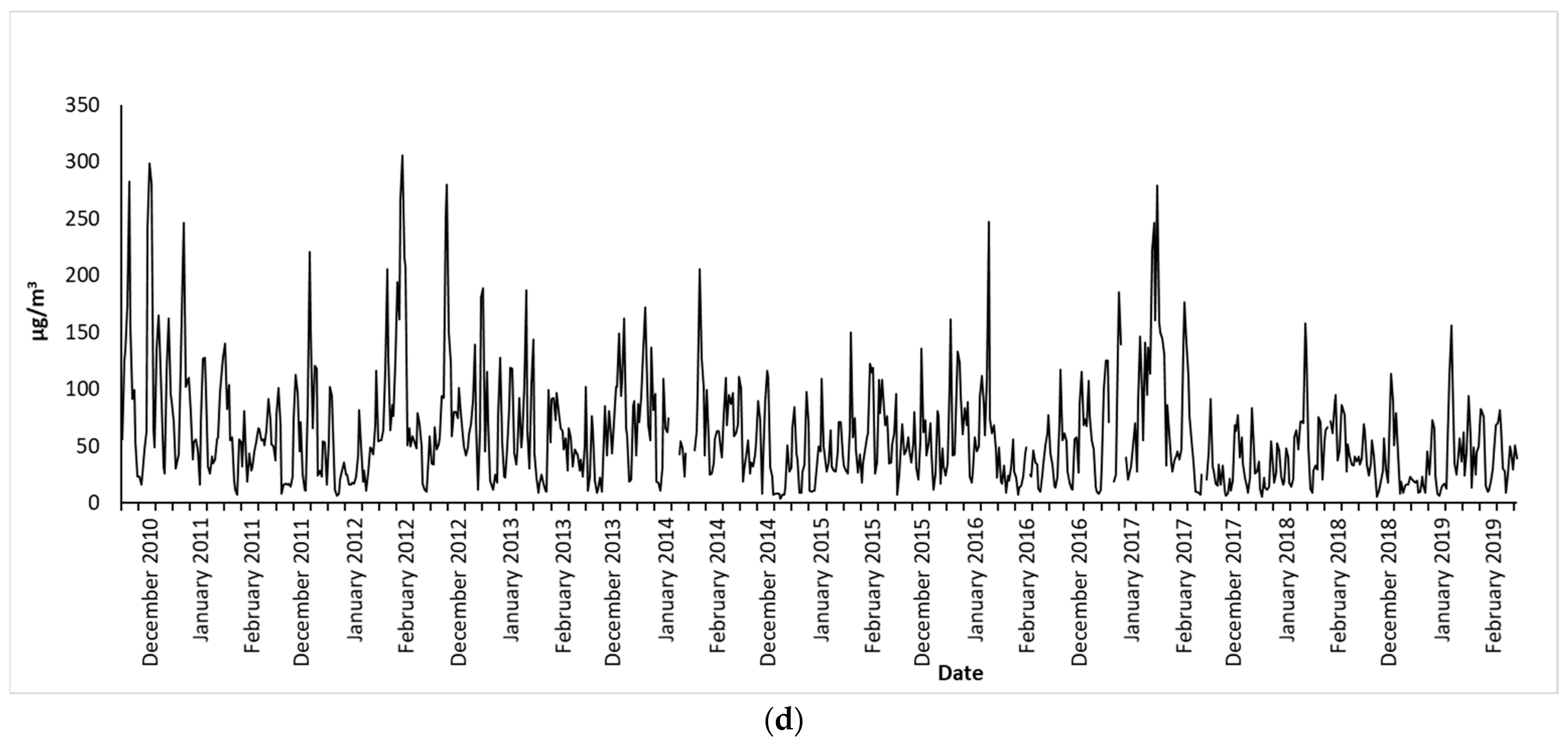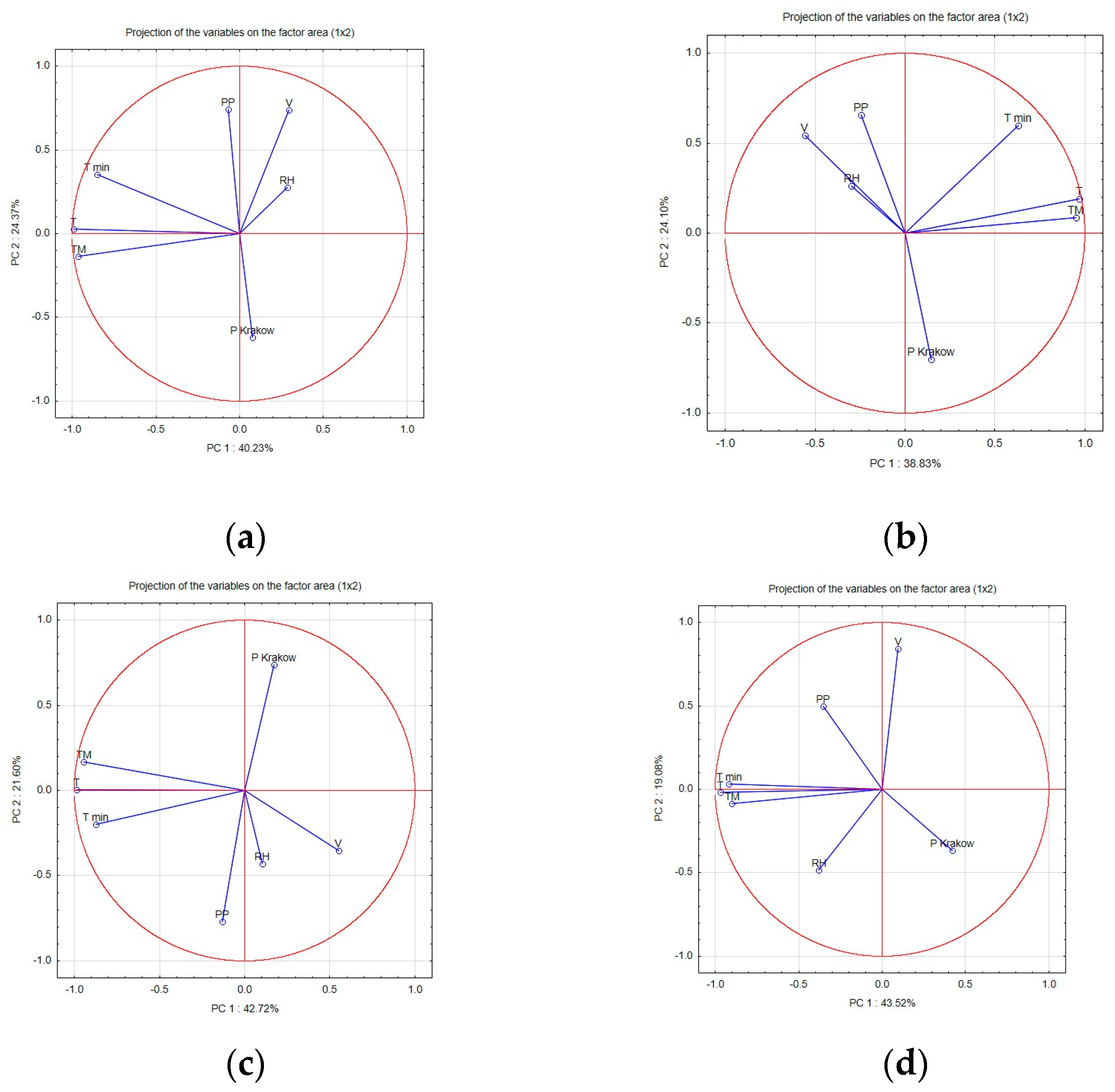Assessment of the Effect of Meteorological Conditions on the Concentration of Suspended PM2.5 Particulate Matter in Central Europe
Abstract
:1. Introduction
2. Materials and Methods
3. Results and Discussion
3.1. PM2.5 Levels—Seasonal Variation
3.2. PCA Analysis
4. Conclusions
Author Contributions
Funding
Institutional Review Board Statement
Informed Consent Statement
Data Availability Statement
Conflicts of Interest
References
- Air Quality in Europe—2015 Report. Available online: https://www.eea.europa.eu/publications/air-quality-in-europe-2015 (accessed on 21 May 2023).
- Air Quality in Europe—2017 Report. Available online: https://www.eea.europa.eu/publications/air-quality-in-europe-2017 (accessed on 21 May 2023).
- Zgłobicki, W.; Baran-Zgłobicka, B. Air pollution in major Polish cities in the period 2005–2021: Intensity, effects and attempts to reduce it. Environ. Res. 2024, 240, 117497. [Google Scholar] [CrossRef] [PubMed]
- Air Quality in Europe—2018 Report. Available online: https://www.eea.europa.eu//publications/air-quality-in-europe-2018 (accessed on 12 June 2023).
- Sprawozdanie Specjalne nr 23 z 2018 Roku pod Tytułem “Zanieczyszczenie Powietrza—Nasze Zdrowie Nadal nie jest Wystarczająco Chronione”, No. 23, Paragraph 29. Available online: https://op.europa.eu/webpub/eca/special-reports/air-quality-23-2018/pl/#chapter3 (accessed on 21 June 2023).
- Journal Laws of 2012, Item 1031. Available online: https://eli.gov.pl/eli/DU/2012/1031/ogl/pol (accessed on 31 May 2023).
- Roczna Ocena Jakości Powietrza w Województwie Małopolskim, Raport Wojewódzki za Rok 2018, GIOŚ, Departament Monitoringu Środowiska, Regionalny Wydział Monitoringu Środowiska w Krakowie, Kraków 2019 r (Annual Assessment of Air Quality in the Lesser Poland Voivodeship, 2019). Available online: https://powietrze.gios.gov.pl/pjp/publications/card/14060 (accessed on 11 April 2023).
- Traczyk, P.; Gruszecka-Kosowska, A. The Condition of Air Pollution in Kraków, Poland, in 2005–2020, with Health Risk Assessment. Int. J. Environ. Res. Public Health 2020, 17, 6063. [Google Scholar] [CrossRef] [PubMed]
- European Environment Agency. Particulate Matter from Natural Sources and Related Reporting under the EU Air Quality Directive in 2008 and 2009; European Environment Agency: Copenhagen, Denmark, 2012. Available online: https://data.europa.eu/doi/10.2800/55574 (accessed on 21 May 2023).
- Household Air Pollution. Available online: https://www.who.int/news-room/fact-sheets/detail/household-air-pollution-and-health?gclid=EAIaIQobChMIhsKpvLTAgAMVRgqiAx0LWgPbEAAYASAAEgI6PPD_BwE (accessed on 12 June 2023).
- Karagulian, F.; Belis, C.A.; Dora, C.F.C.; Prüss-Ustün, A.M.; Bonjour, S.; Adair-Rohani, H.; Amann, M. Contributions to cities’ ambient particulate matter (PM): A systematic review of local source contributions at global level. Atmos. Environ. 2015, 120, 475–483. [Google Scholar] [CrossRef]
- Krzeszowiak, J.; Pawlas, K. Particulate matter (PM2.5 and PM10), properties and epidemiological significance for respiratory and cardiovascular diseases. A review of the literature on the effects of short- and long-term exposure. Med. Srod. 2018, 21, 7–13. [Google Scholar] [CrossRef]
- WHO Air Quality Guidelines for Particulate Matter, Ozone, Nitrogen Dioxide and Sulfur Dioxide: Global Update 2005: Summary of Risk Assessment. Available online: https://apps.who.int/iris/handle/10665/69477 (accessed on 11 April 2023).
- Mačejná, L.; Zacharová, A.; Ollerová, H.; Škvareninová, J.; Škvarenina, J. Hydrobiochemical balance of total mercury in a forest catchment area at former cinnabar mining locality. J. Hydrol. Hydromech. 2021, 69, 209–219. [Google Scholar] [CrossRef]
- Xu, L.; Chen, J.; Niu, Z.; Yin, L.; Chen, Y. Characterization of mercury in atmospheric particulate matter in the southeast coastal cities of China. Atmos. Pollut. Res. 2013, 4, 454–461. [Google Scholar] [CrossRef]
- Kim, K.-H.; Kabir, E.; Kabir, S. A review on the human health impact of airborne particulate matter. Environ. Int. 2015, 74, 136–143. [Google Scholar] [CrossRef] [PubMed]
- Khomenko, S.; Cirach, M.; Pereira-Barboza, E.; Mueller, N.; Barrera-Gómez, J.; Rojas-Rueda, D.; de Hoogh, K.; Hoek, G.; Nieuwenhuijsen, M. Premature mortality due to air pollution in European cities: A health impact assessment. Lancet Planet. Health 2021, 5, e121–e134. [Google Scholar] [CrossRef]
- IARC: Outdoor Air Pollution a Leading Environmental Cause of Cancer Deaths. Available online: https://www.iarc.who.int/wp-content/uploads/2018/07/pr221_E.pdf (accessed on 11 May 2023).
- Rajagopalan, S.; Al-Kindi, S.G.; Brook, R.D. Air Pollution and Cardiovascular Disease. J. Am. Coll. Cardiol. 2018, 72, 2054–2070. [Google Scholar] [CrossRef]
- Ebrahimi, H.; Aryan, Z.; Moghaddam, S.S.; Bisignano, C.; Rezaei, S.; Pishgar, F.; Force, L.M.; Abolhassani, H.; Abu-Gharbieh, E.; Advani, S.M.; et al. Global, regional, and national burden of respiratory tract cancers and associated risk factors from 1990 to 2019 a systematic analysis for the Global Burden of Disease Study 2019. Lancet Respir. Med. 2021, 9, 1030–1049. [Google Scholar] [CrossRef]
- Zanobetti, A.; Schwartz, J. Air pollution and emergency admissions in Boston, MA. J. Epidemiol. Community Health 2006, 60, 890–895. [Google Scholar] [CrossRef] [PubMed]
- Belleudi, V.; Faustini, A.; Stafoggia, M.; Cattani, G.; Marconi, A.; Perucci, C.A.; Forastiere, F. Impact of Fine and Ultrafine Particles on Emergency Hospital Admissions for Cardiac and Respiratory Diseases. Epidemiology 2010, 21, 414–423. [Google Scholar] [CrossRef]
- Health Impacts of Air Pollution in Europe. 2022. Available online: https://www.eea.europa.eu/publications/air-quality-in-europe-2022/health-impacts-of-air-pollution (accessed on 21 May 2023).
- WHO Global Air Quality Guidelines. Particulate Matter (PM2.5 and PM10), Ozone, Nitrogen Dioxide, Sulfur Dioxide and Carbon Monoxide. Available online: https://iris.who.int/bitstream/handle/10665/345329/9789240034228-eng.pdf?sequence=1 (accessed on 12 June 2023).
- Kozak, J. Wpływ Wybranych Elementów Meteorologicznych na Stężenia Pyłu Zawieszonego w Bielsku-Białej. Ph.D. Thesis, University of Agriculture in Kraków, Kraków, Poland, 2007. [Google Scholar]
- Czarnecka, M.; Nidzgorska-Lencewicz, J. Warunki Meteorologiczne kształtujące jakość Powietrza w styczniu i w lipcu 2006 roku w Szczecinie. Acta Agrophys. 2008, 12, 55–72. [Google Scholar]
- Majewski, G.; Przewoźniczuk, W.; Kleniewska, M.; Rozbicka, K. Analiza zmienności wybranych zanieczyszczeń powietrza w zależności od opadów atmosferycznych w rejonie Ursynowa. Acta Agrophys. 2009, 13, 419–434. [Google Scholar]
- Knozová, G. Zanieczyszczenie pyłem zawieszonym na Morawach Południowych przy różnych typach cyrkulacji. In Rola Cyrkulacji Atmosfery w Kształtowaniu Klimatu, 1st ed.; Bielec-Bąkowska, Z., Łupikasza, E., Widawski, A., Eds.; Kat Klima, Wydział Nauk o Ziemi Uniwersytetu Śląskiego: Sosnowiec, Poland, 2012; pp. 287–297. [Google Scholar]
- Liu, Y.; Zhou, Y.; Lu, J. Exploring the relationship between air pollution and meteorological conditions in China under environmental governance. Sci. Rep. 2020, 10, 14518. [Google Scholar] [CrossRef] [PubMed]
- Radzka, E. The Effect of Meteorological Conditions on Air Pollution in Siedlce. J. Ecol. Eng. 2020, 21, 97–104. [Google Scholar] [CrossRef] [PubMed]
- Bokwa, A.; Wypych, A.; Hajto, M.J. Role of Fog in Urban Heat Island Modification in Krakow, Poland. Aerosol Air Qual. Res. 2018, 18, 178–187. [Google Scholar] [CrossRef]
- Journal of Laws 1991 No. 77, Item 335. Available online: https://isap.sejm.gov.pl/isap.nsf/download.xsp/WDU19910770335/U/D19910335Lj.pdf (accessed on 31 May 2023).
- EN 14907:2005; Ambient Air Quality—Standard Gravimetric Measurement Method for the Determination of the PM2.5 Mass Fraction of Suspended Particulate Matter. European Committee for Standardization: Brussels, Belgium, 2005.
- Peel, M.C.; Finlayson, B.L.; McMahon, T.A. Updated world map of the Köppen-Geiger climate classification. Hydrol. Earth Syst. Sci. 2007, 11, 1633–1644. [Google Scholar] [CrossRef]
- Aczel, A.D. Statistics in Management; PWN: Warsaw, Poland, 2018; pp. 1–1222. [Google Scholar]
- Niedźwiedź, T. Sytuacje Synoptyczne i ich Wpływ na Zróżnicowanie Przestrzenne Wybranych Elementów Klimatu w Dorzeczu Górnej Wisły; Rozprawy Habilitacyjne UJ, No. 58; Jagiellonian University Publishing House: Kraków, Poland, 1981. [Google Scholar]
- Niedźwiedź, T. Catalogue of Synoptic Situations in the Upper Vistula River Basin (1873.09–2015.12); Department of Climatology, Faculty of Earth Sciences, University of Silesia: Sosnowiec, Poland, 2016; Available online: http://klimat.wnoz.us.edu.pl (accessed on 30 April 2023).
- Bokwa, A.; Hajto, M.J.; Walawender, J.P.; Szymanowski, M. Influence of diversified relief on the urban heat island in the city of Kraków, Poland. Theor. Appl. Climatol. 2015, 122, 365–382. [Google Scholar] [CrossRef]
- Jędruszkiewicz, J.; Piotrowski, P.; Pietras, B. Koncentracja zanieczyszczeń pyłowych powietrza PM2,5 w Krakowie w latach 2010–2014. Acta Geogr. Lodz. 2016, 104, 123–135. [Google Scholar]
- Manisalidis, I.; Stavropoulou, E.; Stavropoulos, A.; Bezirtzoglou, E. Environmental and Health Impacts of Air Pollution: A Review. Front. Public Health 2020, 8, 505570. [Google Scholar] [CrossRef]
- Harrison, R.M.; Laxen, D.; Moorcroft, S.; Laxen, K. Processes affecting concentrations of fine particulate matter (PM2.5) in the UK atmosphere. Atmos. Environ. 2012, 46, 115–124. [Google Scholar] [CrossRef]
- Ocena Jakości Powietrza w Województwie Małopolskim w 2012 Roku, Wojewódzki Inspektorat Ochrony Środowiska, Kraków 2013 r (Assessment of Air Quality in the Lesser Poland Voivodeship in 2012, 2013). Available online: https://powietrze.gios.gov.pl/pjp/rwms/publications/card/345?lang=en (accessed on 11 April 2023).
- Danek, T.; Weglinska, E.; Zareba, M. The influence of meteorological factors and terrain on air pollution concentration and migration: A geostatistical case study from Krakow, Poland. Sci. Rep. 2022, 12, 11050. [Google Scholar] [CrossRef] [PubMed]
- Juda-Rezler, K.; Toczko, B. Pyły Drobne w Atmosferze. Kompendium Wiedzy o Zanieczyszczeniu Powietrza Pyłem Zawieszonym w Polsce, Biblioteka Monitoringu Środowiska; GIOŚ: Warszawa, Poland, 2016; pp. 1–279. [Google Scholar]
- Rozbicka, K.; Michalak, M. Charakterystyka stężeń wybranych zanieczyszczeń powietrza na obszarze Warszawy (Poland). Prz. Nauk. Inż. Kształt. Środ. 2015, 68, 193–206. [Google Scholar]
- Gliniak, M.; Zuśka, Z.; Miczyński, J. Ocena poziomu pyłowego zanieczyszczenia powietrza w aglomeracji krakowskiej na przykładzie Al. A. Mickiewicza. Logistyka 2015, 4, 8876–8881. [Google Scholar]
- Borowiak, K.; Budka, A.; Lisiak-Zielińska, M. Air pollution in summer and winter—Real threat. Ciepłownictwo Ogrzew. Went. 2023, 2, 21–26. [Google Scholar]
- Cembrzyńska, J.; Krakowiak, E.; Brewczyński, P.Z. Zanieczyszczenie powietrza pyłem zawieszonym PM10 oraz PM2.5 w warunkach silnej antropopresji na przykładzie miasta Sosnowiec. Med. Sr.—Environ. Med. 2012, 15, 31–38. [Google Scholar]
- Cesari, D.; De Benedetto, G.E.; Bonasoni, P.; Busetto, M.; Dinoi, A.; Merico, E.; Chirizzi, D.; Cristofanelli, P.; Donateo, A.; Grasso, F.M.; et al. Seasonal variability of PM2.5 and PM10 composition and sources in an urban background site in Southern Italy. Sci. Total Environ. 2018, 612, 202–213. [Google Scholar] [CrossRef]
- Zaręba, M.; Danek, T. Analysis of Air Pollution Migration during COVID-19 Lockdown in Krakow, Poland. Aerosol. Air Qual. Res. 2022, 22, 210275. [Google Scholar] [CrossRef]
- Zuśka, Z.; Kopcińska, J.; Dacewicz, E.; Skowera, B.; Wojkowski, J.; Ziernicka–Wojtaszek, A. Application of the Principal Component Analysis (PCA) Method to Assess the Impact of Meteorological Elements on Concentrations of Particulate Matter (PM10): A Case Study of the Mountain Valley (the Sącz Basin, Poland). Sustainability 2019, 11, 6740. [Google Scholar] [CrossRef]
- Mindas, J.; Skvarenina, J. Chemical composition of fog/cloud and rain/snow water in biosphere reserve Pol’ana. Ecology 1995, 14, 125–137. [Google Scholar]
- Walczewski, J.; Feleksy-Bielak, M.; Dębicka, K.; Śliwińska, U. Wskaźniki meteorologicznych warunków dyspersji zanieczyszczeń powietrza i ich zmienność w Krakowie w latach 1990–1999. Wiad. Instututu Meteorol. I Gospod. Wodnej 2000, 23, 13–27. [Google Scholar]
- Bokwa, A. Environmental impacts of long-term air pollution changes in Krakow, Poland. Pol. J. Envir. Stud. 2008, 17, 673–686. Available online: http://www.pjoes.com/Issue-5-2008,3821 (accessed on 26 May 2024).
- Bokwa, A. Infuence of air temperature inversions on the air pollution dispersion conditions in Krakow. Pr. Geogr. 2011, 126, 41–51. [Google Scholar]
- Ćwiek, K.; Majewski, G. Wpływ elementów meteorologicznych na kształtowanie się stężeń zanieczyszczeń powietrza na przykładzie Krakowa. Prz. Nauk.–Inż. Kształ. Środ. 2015, 67, 54–66. [Google Scholar]
- Kalbarczyk, R. Temporal changes in concentration of pm10 dust in Poznań, middle-west Poland as dependent on meteorological conditions. Appl. Ecol. Environ. Res. 2018, 16, 1999–2014. [Google Scholar] [CrossRef]
- Niedźwiedź, T.; Łupikasza, E.B.; Małarzewski, Ł.; Budzik, T. Surface-based nocturnal air temperature inversions in southern Poland and their influence on PM10 and PM2.5 concentrations in Upper Silesia. Theor. Appl. Clim. 2021, 146, 897–919. [Google Scholar] [CrossRef]
- Shelton, S.; Liyanage, G.; Jayasekara, S.; Pushpawela, B.; Rathnayake, U.; Jayasundara, A.; Jayasooriya, L.D. Seasonal Variability of Air Pollutants and Their Relationships to Meteorological Parameters in an Urban Environment. Adv. Meteorol. 2022, 2022, 5628911. [Google Scholar] [CrossRef]
- Houthuijs, D.; Breugelmans, O.; Hoek, G.; Vaskövi, E.; Miháliková, E.; Pastuszka, J.S.; Jirik, V.; Sachelarescu, S.; Lolova, D.; Meliefste, K.; et al. PM10 and PM2.5 concentrations in Central and Eastern Europe: Results from the Cesar study. Atmos. Environ. 2001, 35, 2757–2771. [Google Scholar] [CrossRef]
- Hasan, F.B.; Midyurova, B.N.; Mihalev, T.M. Temperature Effect on Particulate Matter Concentrations PM 10 during the heating season in Burgas. IOP Conf. Ser. Mater. Sci. Eng. 2021, 1031, 012002. [Google Scholar] [CrossRef]
- Kirešová, S.; Guzan, M. Determining the Correlation between Particulate Matter PM10 and Meteorological Factors. Eng 2022, 3, 343–363. [Google Scholar] [CrossRef]
- Šmejkalová, A.H.; Brzezina, J. The Effect of Drought on PM Concentrations in the Czech Republic. Aerosol. Air Qual. Res. 2022, 22, 220130. [Google Scholar] [CrossRef]
- Jandacka, D.; Durcanska, D.; Nicolanska, M.; Holubcik, M. Impact of Seasonal Heating on PM10 and PM2.5 Concentrations in Sučany, Slovakia: A Temporal and Spatial Analysis. Fire 2024, 7, 150. [Google Scholar] [CrossRef]




| Year | 2010 | 2011 | 2012 | 2013 | 2014 | 2015 | 2016 | 2017 | 2018 | 2019 |
|---|---|---|---|---|---|---|---|---|---|---|
| PM2.5 (µg/m3) | 35 | 37 | 41 | 33 | 33 | 34 | 30 | 32 | 31 | 25 |
| Spring | PM2.5 | TM | Tm | T | PP | V | RH | PKrakow |
|---|---|---|---|---|---|---|---|---|
| PM2.5 | 1.00 | |||||||
| TM | −0.34 | 1.00 | ||||||
| Tm | −0.61 | 0.70 | 1.00 | |||||
| T | −0.49 | 0.95 | 0.86 | 1.00 | ||||
| PP | −0.19 | −0.01 | 0.22 | 0.07 | 1.00 | |||
| V | −0.28 | −0.28 | −0.05 | −0.22 | 0.08 | 1.00 | ||
| RH | −0.03 | −0.42 | 0.10 | −0.26 | 0.38 | 0.02 | 1.00 | |
| PKrakow | 0.26 | −0.02 | −0.16 | −0.07 | −0.22 | −0.17 | −0.23 | 1.00 |
| Summer | PM2.5 | TM | Tm | T | PP | V | RH | PKrakow |
| PM2.5 | 1.00 | |||||||
| TM | 0.59 | 1.00 | ||||||
| Tm | 0.25 | 0.53 | 1.00 | |||||
| T | 0.58 | 0.94 | 0.70 | 1.00 | ||||
| PP | −0.09 | −0.11 | 0.10 | −0.10 | 1.00 | |||
| V | −0.38 | −0.27 | 0.04 | −0.23 | 0.07 | 1.00 | ||
| RH | −0.28 | −0.48 | 0.09 | −0.42 | 0.38 | 0.04 | 1.00 | |
| PKrakow | 0.15 | 0.04 | −0.16 | 0.01 | −0.29 | −0.22 | −0.26 | 1.00 |
| Autumn | PM2.5 | TM | Tm | T | PP | V | RH | PKrakow |
| PM2.5 | 1.00 | |||||||
| TM | −0.30 | 1.00 | ||||||
| Tm | −0.53 | 0.71 | 1.00 | |||||
| T | −0.45 | 0.93 | 0.90 | 1.00 | ||||
| PP | −0.20 | 0.03 | 0.21 | 0.11 | 1.00 | |||
| V | −0.40 | −0.25 | 0.03 | −0.12 | 0.10 | 1.00 | ||
| RH | 0.26 | −0.50 | −0.22 | −0.42 | 0.17 | −0.12 | 1.00 | |
| PKrakow | 0.06 | 0.02 | −0.04 | 0.00 | −0.09 | −0.01 | 0.27 | 1.00 |
| Winter | PM2.5 | TM | Tm | T | PP | V | RH | PKrakow |
| PM2.5 | 1.00 | |||||||
| TM | −0.33 | 1.00 | ||||||
| Tm | −0.58 | 0.78 | 1.00 | |||||
| T | −0.51 | 0.93 | 0.93 | 1.00 | ||||
| PP | −0.21 | 0.16 | 0.22 | 0.22 | 1.00 | |||
| V | −0.59 | 0.11 | 0.30 | 0.24 | 0.17 | 1.00 | ||
| RH | 0.18 | −0.18 | 0.04 | −0.07 | 0.17 | −0.28 | 1.00 | |
| PKrakow | 0.06 | −0.08 | −0.12 | −0.11 | −0.10 | 0.00 | 0.30 | 1.00 |
| Spring | Summer | |||||||
|---|---|---|---|---|---|---|---|---|
| Factor No. | Eigenvalue | % of Total Variance | Cumul. Eigenvalue | Cumul.% | Eigenvalue | % of Total Variance | Cumul. Eigenvalue | Cumul.% |
| PC1 | 2.82 | 40.23 | 2.82 | 40.23 | 2.72 | 38.83 | 2.72 | 38.83 |
| PC2 | 1.71 | 24.37 | 4.52 | 64.60 | 1.69 | 24.10 | 4.40 | 62.92 |
| PC3 | 1.01 | 14.41 | 5.53 | 79.01 | 1.03 | 14.78 | 5.44 | 77.70 |
| PC4 | 0.76 | 10.79 | 6.29 | 89.80 | 0.70 | 10.01 | 6.14 | 87.72 |
| PC5 | 0.59 | 8.45 | 6.88 | 98.25 | 0.65 | 9.26 | 6.79 | 96.97 |
| Autumn | Winter | |||||||
| PC1 | 2.99 | 42.72 | 2.99 | 42.72 | 3.05 | 43.52 | 3.05 | 43.52 |
| PC2 | 1.51 | 21.60 | 4.50 | 64.32 | 1.34 | 19.08 | 4.38 | 62.60 |
| PC3 | 1.11 | 15.81 | 5.61 | 80.13 | 1.12 | 16.07 | 5.51 | 78.66 |
| PC4 | 0.68 | 9.67 | 6.29 | 89.80 | 0.77 | 11.06 | 6.28 | 89.72 |
| PC5 | 0.56 | 8.06 | 6.85 | 97.86 | 0.57 | 8.13 | 6.85 | 97.85 |
| Factor Coefficients of Variables Based on Correlations | ||||||
|---|---|---|---|---|---|---|
| Spring | Summer | |||||
| Meteorological Elements | PC1 | PC2 | PC3 | PC1 | PC2 | PC3 |
| TM | −0.963 | −0.137 | 0.050 | 0.950 | 0.087 | −0.019 |
| Tm | −0.852 | 0.355 | 0.017 | 0.628 | 0.597 | 0.022 |
| T | −0.992 | 0.027 | 0.040 | 0.970 | 0.192 | 0.005 |
| PP | −0.069 | 0.743 | −0.200 | −0.247 | 0.657 | −0.306 |
| RH | 0.284 | 0.276 | 0.823 | −0.299 | 0.262 | 0.853 |
| V | 0.295 | 0.738 | −0.403 | −0.557 | 0.544 | −0.386 |
| PKrakow | 0.077 | −0.622 | −0.352 | 0.143 | −0.700 | −0.251 |
| Autumn | Winter | |||||
| Meteorological Elements | PC1 | PC2 | PC3 | PC1 | PC2 | PC3 |
| TM | −0.944 | 0.168 | −0.090 | −0.899 | −0.086 | 0.279 |
| Tm | −0.875 | −0.197 | −0.069 | −0.919 | 0.030 | 0.202 |
| T | −0.986 | 0.004 | −0.065 | −0.969 | −0.018 | 0.221 |
| PP | −0.133 | −0.768 | −0.242 | −0.355 | 0.500 | −0.587 |
| RH | 0.103 | −0.431 | 0.831 | −0.378 | −0.485 | −0.592 |
| V | 0.551 | −0.352 | −0.582 | 0.097 | 0.841 | 0.233 |
| PKrakow | 0.170 | 0.739 | −0.042 | 0.421 | −0.368 | 0.458 |
| Winter | |||
|---|---|---|---|
| Meteorological Elements | PC1 | PC2 | PC3 |
| T | −0.88 | −0.40 | 0.22 |
| TM | −0.87 | −0.22 | 0.25 |
| Tm | −0.77 | −0.51 | 0.22 |
| H | −0.12 | 0.84 | 0.44 |
| V | −0.72 | −0.32 | −0.52 |
| PP | −0.07 | 0.16 | 0.43 |
| VM | −0.72 | 0.41 | 0.49 |
| Po 50N20E | −0.31 | 0.89 | 0.24 |
| Year of Each Study | Research Locations | Main Findings | Methodology | Title and Authors |
|---|---|---|---|---|
| November 1995 to October 1996 | Six Central and Eastern European countries: Bulgaria, Czech Republic, Hungary, Poland, Romania, and Slovakia | The CESAR and PEACE studies showed that mean PM10 concentrations during the heating season are generally higher in Central and Eastern Europe than in Scandinavia and Western Europe | Analysis of variance and correlation analysis | ‘PM10 and PM2.5 concentrations in Central and Eastern Europe: results from the Cesar study’, Houthuijs et al. [60] |
| October to March in four years, 2017–2020 | Burgas, Bulgaria | A decrease in temperature has a negative effect on PM10 levels in January and February | Comparison of mean PM concentrations during heating and non-heating seasons | ‘Temperature effect on PM10 concentrations during the heating season in Burgas’, Hasan et al. [61] |
| January, March, and May 2022 | First measurement—Košice, Slovakia; second measurement—a small village near Košice (one street with five family houses clustered together) | Strong correlation between PM and wind speed, humidity, and temperature | Correlation analysis | ‘Determining the correlation between particulate matter PM10 and meteorological factors’, Kirešová and Guzan [62] |
| 10-year period from 2010 to 2019, during the growing season (April–September) | Czech Republic | PM10 and PM2.5 concentrations were strongly correlated with soil temperature and soil moisture | Dunn test for multiple comparison of mean PM concentrations between station type, separately for dry and wet period | ‘The effect of drought on PM concentrations in the Czech Republic’, Šmejkalová and Brzezina [63] |
| Winter 2019 | Village of Sučany, Slovakia | Correlation between the heating season, the PM concentration, and wind direction | Correlation and regression analyses | ‘Impact of seasonal heating on PM10 and PM2.5 concentrations in Sučany, Slovakia: a temporal and spatial analysis’, Jandacka et al. [64] |
Disclaimer/Publisher’s Note: The statements, opinions and data contained in all publications are solely those of the individual author(s) and contributor(s) and not of MDPI and/or the editor(s). MDPI and/or the editor(s) disclaim responsibility for any injury to people or property resulting from any ideas, methods, instructions or products referred to in the content. |
© 2024 by the authors. Licensee MDPI, Basel, Switzerland. This article is an open access article distributed under the terms and conditions of the Creative Commons Attribution (CC BY) license (https://creativecommons.org/licenses/by/4.0/).
Share and Cite
Ziernicka-Wojtaszek, A.; Zuśka, Z.; Kopcińska, J. Assessment of the Effect of Meteorological Conditions on the Concentration of Suspended PM2.5 Particulate Matter in Central Europe. Sustainability 2024, 16, 4797. https://doi.org/10.3390/su16114797
Ziernicka-Wojtaszek A, Zuśka Z, Kopcińska J. Assessment of the Effect of Meteorological Conditions on the Concentration of Suspended PM2.5 Particulate Matter in Central Europe. Sustainability. 2024; 16(11):4797. https://doi.org/10.3390/su16114797
Chicago/Turabian StyleZiernicka-Wojtaszek, Agnieszka, Zbigniew Zuśka, and Joanna Kopcińska. 2024. "Assessment of the Effect of Meteorological Conditions on the Concentration of Suspended PM2.5 Particulate Matter in Central Europe" Sustainability 16, no. 11: 4797. https://doi.org/10.3390/su16114797






